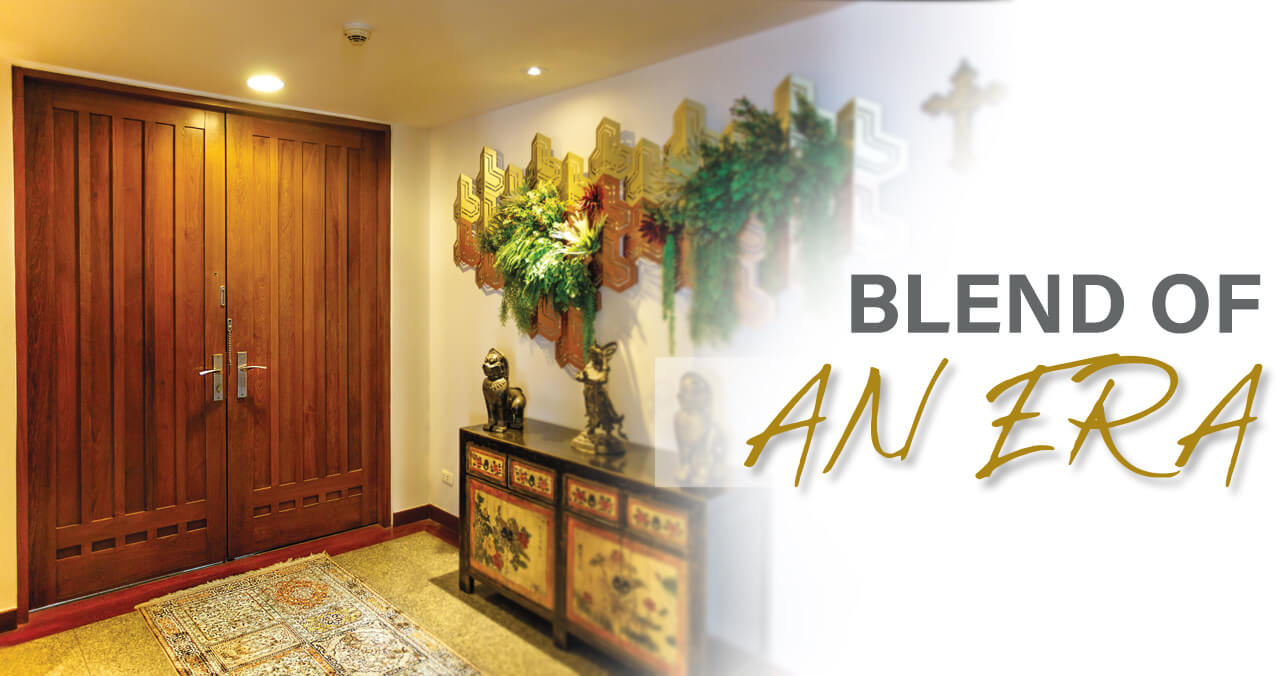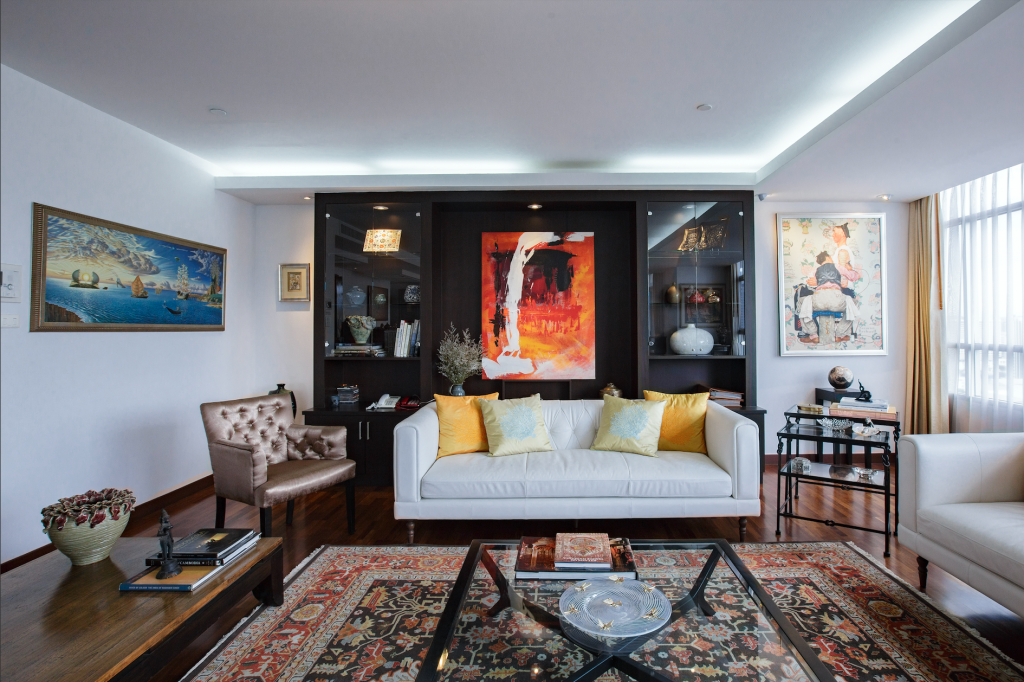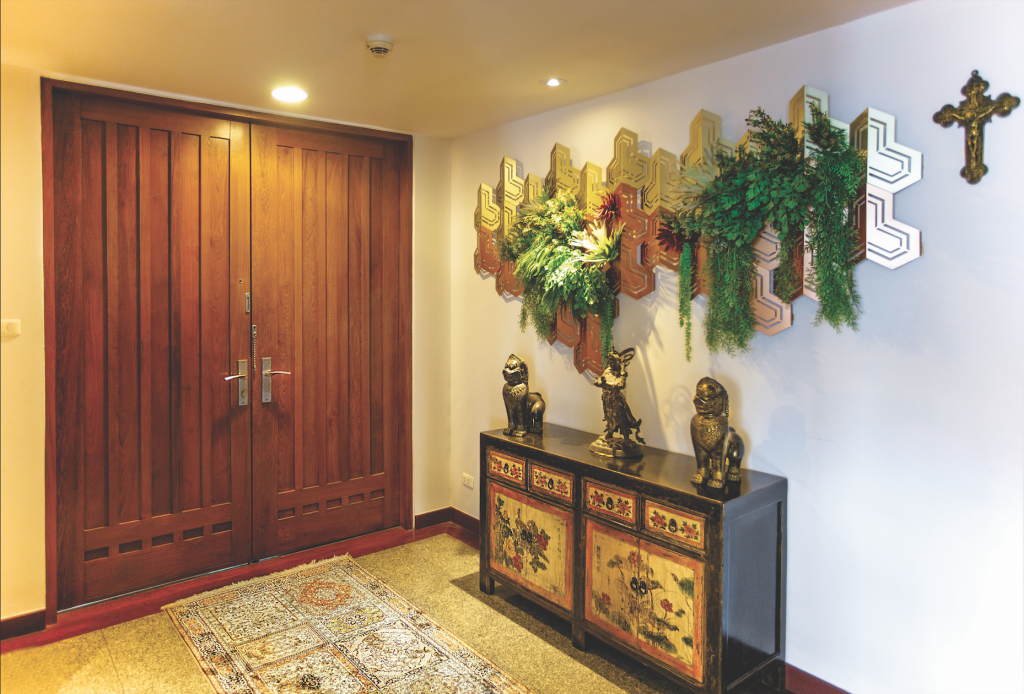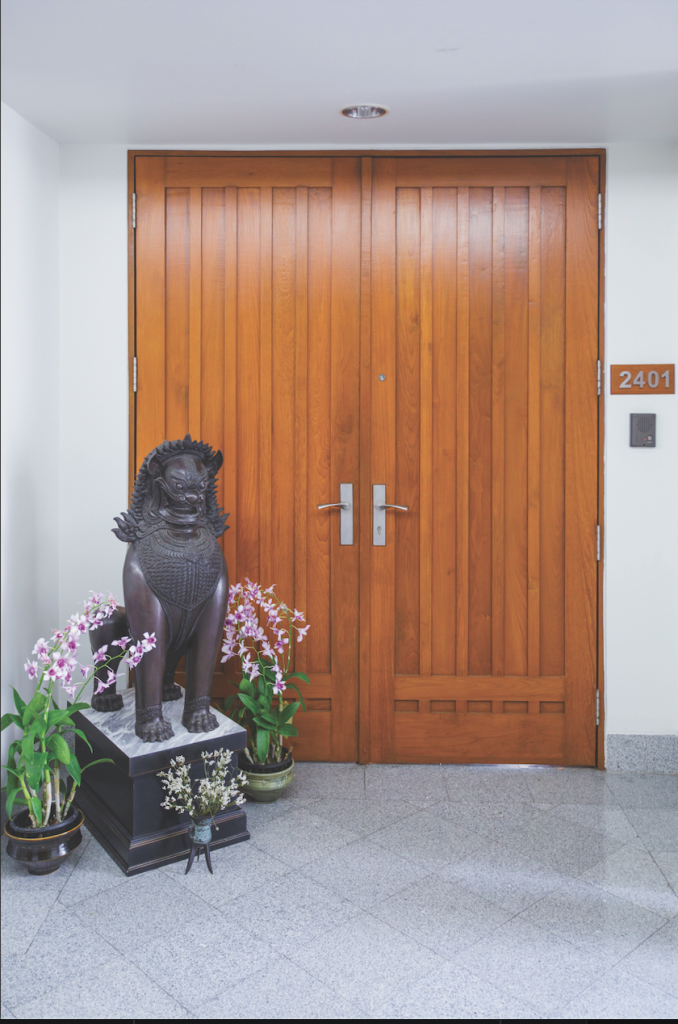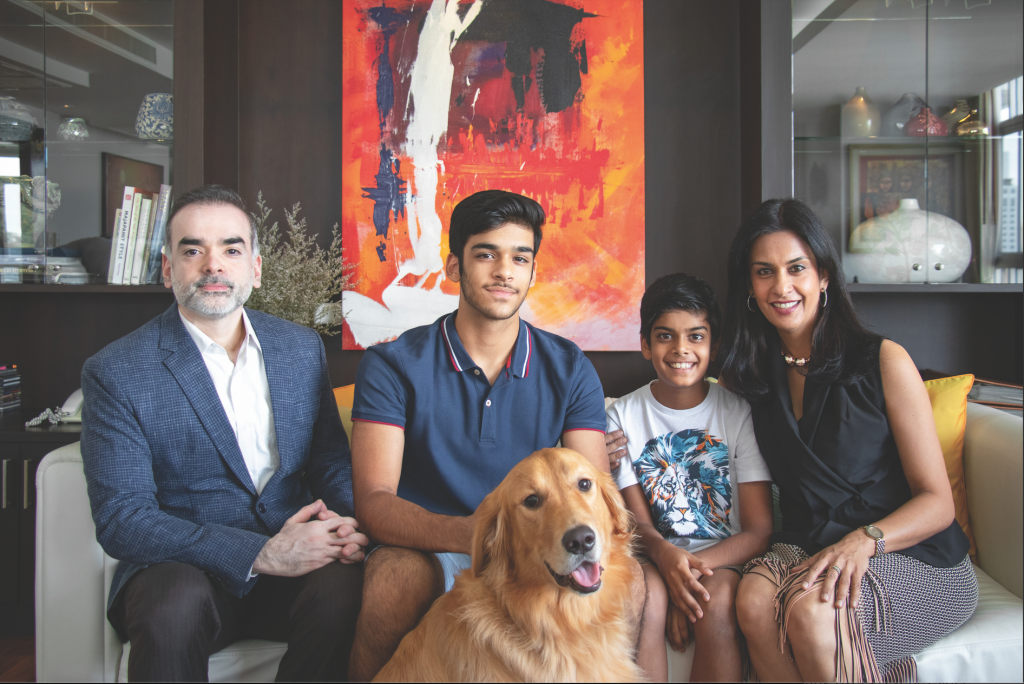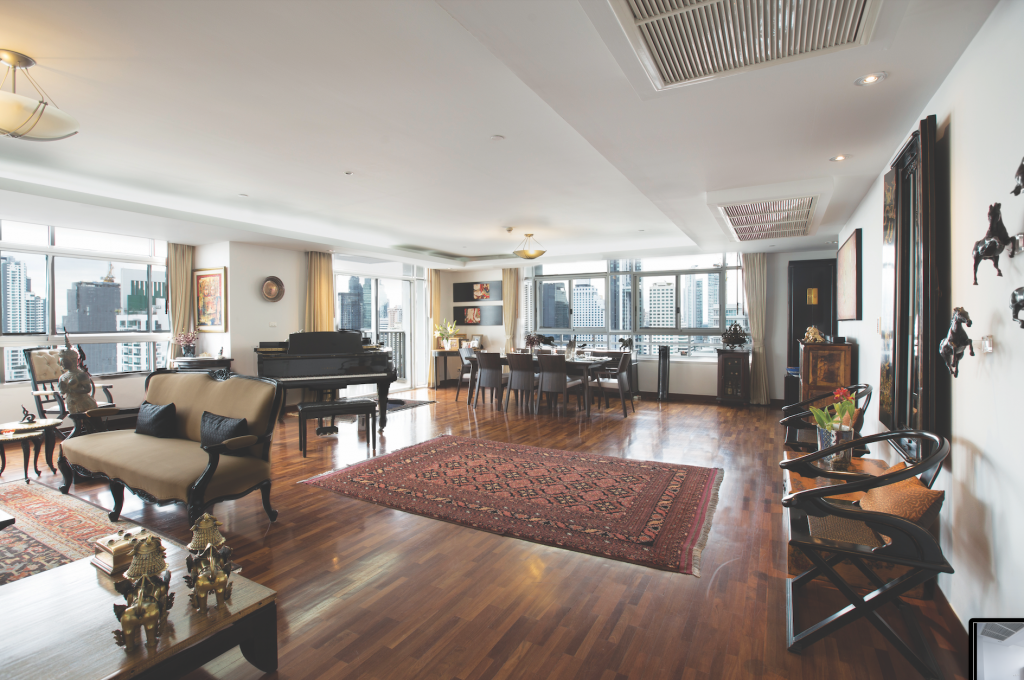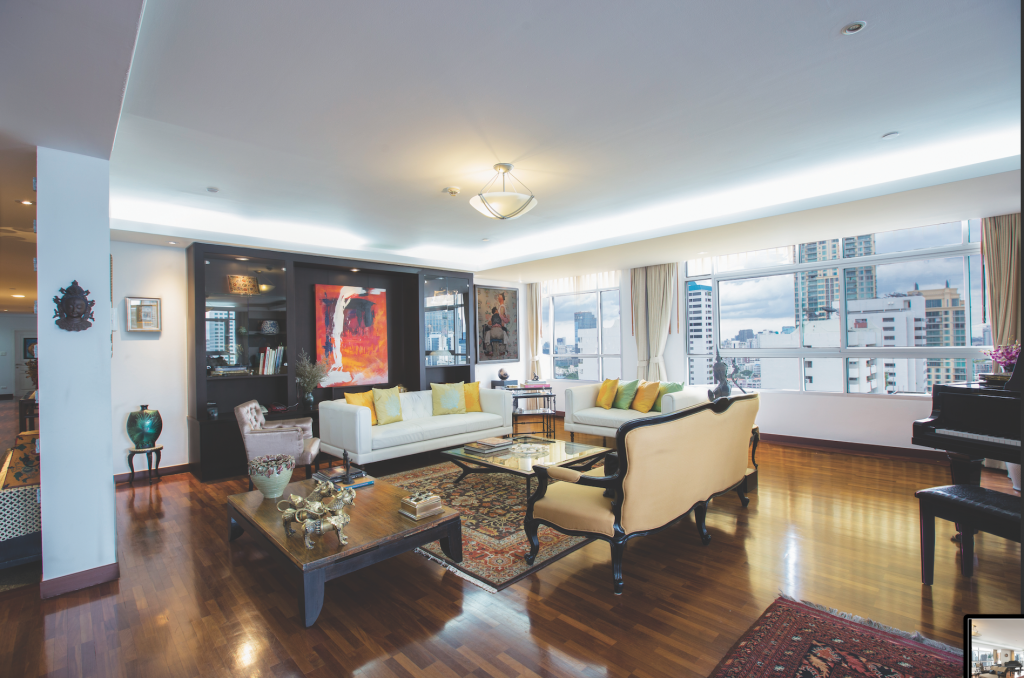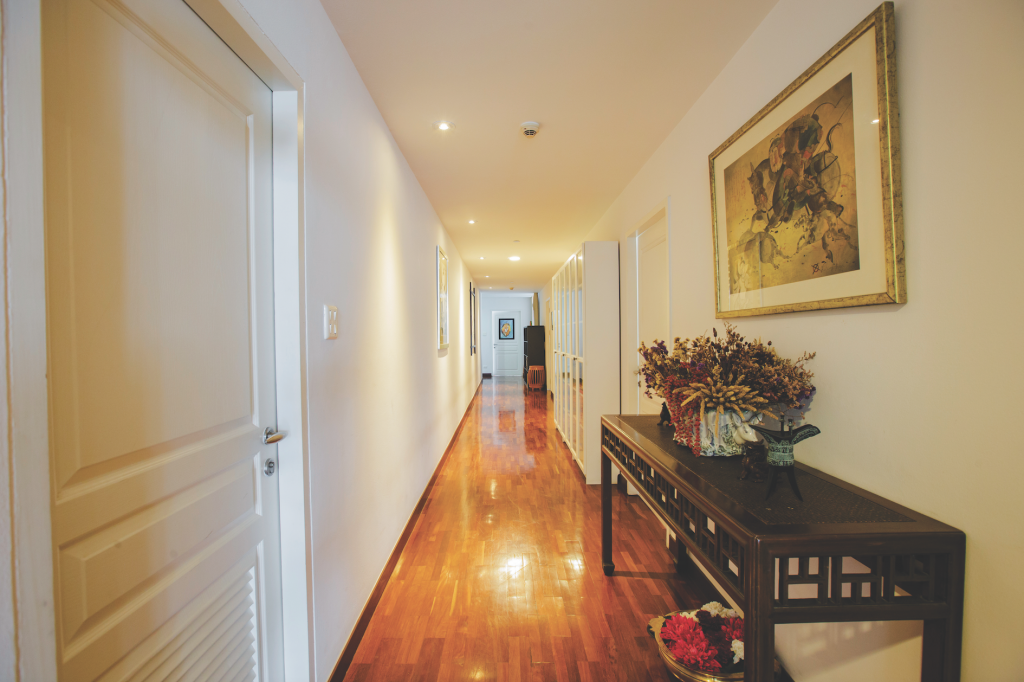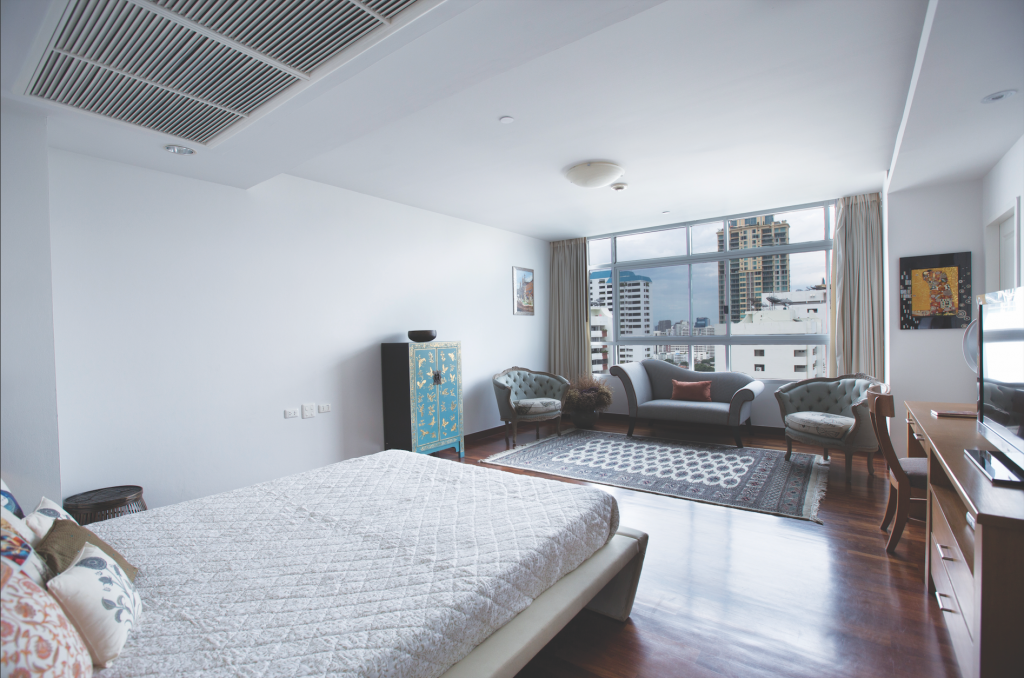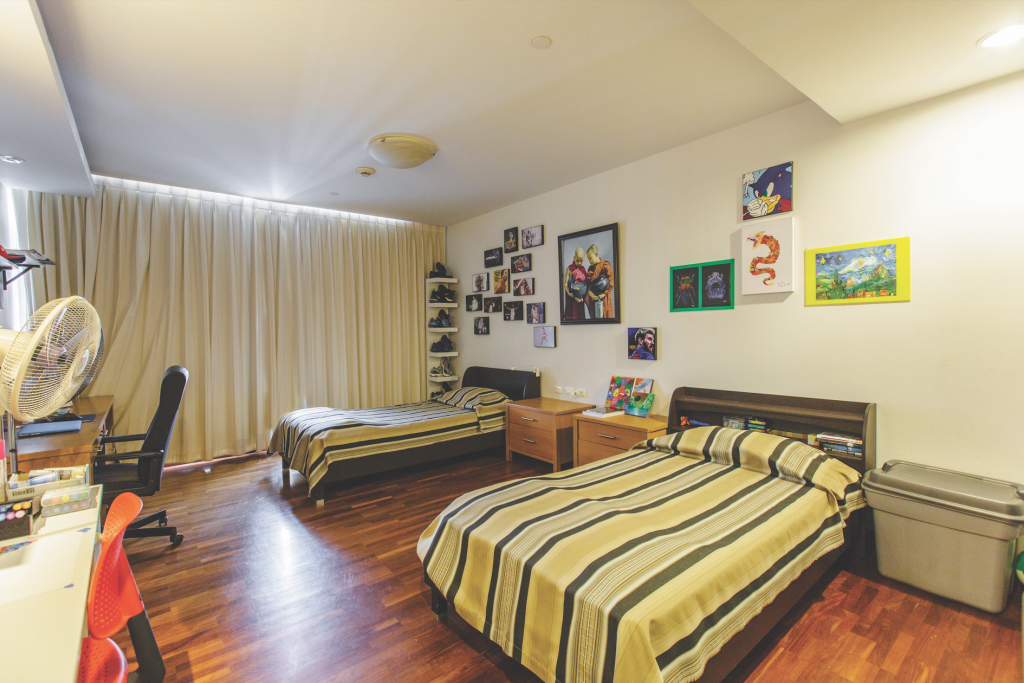The Tharakan family’s timeless home lies betwixt and between cultures and epochs.
By Aiden Jewelle Gonzales
Before we enter the Tharakan family’s condominium in Prasanmitr Thani Tower, Ira Singh Tharakan points out the resplendent brass Khmer lion standing guard in front of their double wooden doors. “I’m drawn to the magnificence and valour of the lion,” she explains, “partly because of my heritage – Singh means lion. You’ll see a lot of singha motifs throughout the house, brought here from all over the world.” True to her assertion, as soon as we walk into the foyer done up in striking shades of bronze and copper, two more lions greet us on the left; custodians hailing from Cambodia that have made their way to the bustling Asoke district.
This international flavour only hints towards the ways that the globetrotting lifestyle of the family, which consists of Ira, her husband Pradeep, sons Maher and Om, and golden retriever Cosmo, has affected their aesthetic and design choices. Having grown up in India, both Ira and Pradeep met in the US, where they went for university. They were posted to Bangkok in 2007, followed by Manila, Jakarta, and finally back to Thailand. Because of the peripatetic experiences provided by their careers – Pradeep works for the Asian Development Bank and Ira works for a private microfinance investment company – their style has evolved with their exposure to life in different countries. Part of that is the practicality that comes with an itinerant lifestyle: “we’ve learnt to find a place with a large service elevator so we can easily transport our larger pieces of furniture,” Ira reveals, “and we’ve also learnt that we can’t have live plants in the house as they would just die.” With that in mind, the foyer boasts a bespoke vertical garden in matte gold and copper, made by an artist at a design fair, with lush thickets of artificial plants adding a splash of green to the space. Opposite is an ornate mirror of magnificent proportions that reflects the oriental carpeting and exotic showpieces that speak to the cultures they’ve adopted along the way.
“Our style is eclectic and very personal, because every piece reflects a certain experience in the countries we’ve visited,” Ira advises. “We like the juxtaposition of tradition and modernity, of Asia and the West, because that’s who we are. We may have grown up in traditional contexts, but we have modern tastes and progressive ideas and our home should reflect that.”
This can be seen most clearly when we turn right from the foyer and into the open-plan, well-appointed space that looks out into Bangkok’s cityscape through end-to-end windows. A black Yamaha grand piano sits with bravura in the middle of the room, serving as a divider to create a separate living and dining area to its left and right, respectively. “The piano is the sixth member of the family,” Ira confides, “it’s followed us everywhere. Playing it was a skill that was passed on to me from my mother, and to her from her father, and one that I’ve passed on to my children.”
We like the juxtaposition of tradition and modernity, of Asia and the West, because that’s who we are.
This homage to heritage and tradition can be seen throughout the space, from the Indian carpet with pride of place in the living room, to the striking bronze mirror with Thai ornamental motifs that is itself an artistic masterpiece, to the gold-fl ecked painting from AGAL that shows Ganesh ascending lotus pads into heaven, affectionately dubbed ‘Stairway to Heaven’ after the eponymous Led Zeppelin song. However, the classic elements are blended seamlessly with contemporary furnishings and art; a liminal space where both the gravitas of religious mythology and the kitschy irreverence of bourgeoisie culture coexist peacefully.
In the living room, where three comfortable but dainty couches surround a bespoke glass and onyx coffee table that matches the nesting tables to the side, the influence of art nouveau is clear in the dynamic lines of the furniture and fixings. There, the family’s favourite piece is the masterful reproduction of Norman Rockwell’s The Tattooist, made by skilled Filipino artist Chriseo Sipat. The stylised scene of a sailor tattooing the name of his latest lover below crossed-out names of past conquests is, in Ira’s words, “an eccentric but perfect vignette of everyday life in America” – and she would know, having lived there for 18 years. Beside it is an abstract painting in black and red made by Australian artist Giles Ashford, the raw emotion of its riotous brushstrokes fitting for a piece entitled Memory of a Love Lost. Prominent against the black display case behind it, the modern work stands in direct contrast to the bronze Thai-style kinnari
(Indian celestial magician) and gold Nepalese lions that add a touch of whimsy to the space.
Across the room is a dining table from Crystal Design Center that has travelled with them for 12 years. Made of wood and leather, it’s elegant but urbane, with the wood carved in a way that maximises comfort. The glass and contemporary design were a deliberate choice by Ira to avoid furniture that overwhelms a room: “I like thin furniture,” she tells us, “so when I see a design that I like, I often work with a carpenter to create a similar piece but with more modern lines.” Other modish pieces elevate the space, from the stainless-steel wine cooler by master craftsman Jorge Jensen, to the bold shapes of the twin panther showpieces from AGAL.
Leading out from the other side of the foyer is a hallway of wonders from their travels; a jaunt back in time to significant places and events: here a 20-year-old rock sculpture from Zimbabwe of a woman is illuminated by a spotlight, there an atypical painting from Mongolia of a pig-hunting warrior greets you as you wander down.
Walking into the guest room, a mix of styles welcome guests into a space designed for serenity. Cool blues and greens create a peaceful air; perfect to encourage the sabai sabai Thai lifestyle. The loveseat and chairs on either side of it are in the Rococo style, reminiscent of a French parlour receiving guests from far and wide. The headboard has been customised with batik cloth from Indonesia to provide the ode to Southeast Asia that’s present in every room.
Beside the guest room is the well-lit bedroom that Maher and Om share, which has their own clear stamp on it, borne of a sense of aesthetics encouraged in them from a young age by their parents. “It’s very important for me to inculcate into my kids pride in their home and a sense of design,” Ira discloses, “because I myself inherited my artistic eye from my mother, and I think more men should involve themselves in their home’s design choices. My husband, for example, loves a well-appointed home and has always been very supportive of my design choices.” True to their taste, the room is divided into two, with a clear delineation between Maher’s love of basketball and Om’s own adept paintings. Basketball prints hang above Maher’s bed, carefully curated and hung up by him, creating a vibrant collage that breathes life into the room.
Finally, the master bedroom is the most dramatic in the apartment, with an accent wall in black against which hangs a large framed strip of wallpaper depicting images from Hindu mythology. Bought all the way from Transylvania, Romania, from a company called Mind the Gap, Ira sees it as bringing pop art to her roots. Across the bed are more eye-catching artworks that transform the room into a gallery of delights; a peek into the inhabitants’ heritage. There’s a painting of Brahma on a swan, his hallowed chariot, and another of Buddha’s footprint done in a very contemporary style.
“We sit on the fence of tradition and modernity, and we’ve infused that sense into our home,” Ira concludes, “it’s why we’ve chosen a location in the centre of town as close to the buzz of metropolitan life as possible, but we’ve also injected traditional elements into our design. But what’s most important is that our house is not only elegant, but it instils a sense of home for everyone who visits.” And to that I say, mission accomplished.


